#*takes all of my anger over things I cannot change (my visa process)
Text
I have yet to see a single version of The Turn Of The Screw (Apart from The Others, which isn’t so much a version as Inspired By, for the liberties it takes) which doesn’t feel forced in some way, or unnatural, or in which I have any sympathy or feelings of good will towards Ms Clayton.
I’ve started The Haunting Of Bly Manor, and idk I just feel like so far the acting for Ms Clayton, Flora, and Miles is iffy at best, unbelievable at worst.
Also, as a Brit, the recent retelling of the story from a US perspective (with both this and The Turning) always ends up making certain things... fall flat? Like there’s no real understanding of the importance of Class in the story, and the way it changes how each character interacts with the others, or why Bly Manor feels the way it does to Ms Clayton. Class is an important part of the story, it explains the anxieties about Miles being influenced by Quint, it explains the distance between Ms Grose and the children, it explains a lot of Miles’ character. The horror aspect of The Turn, in my opinion, is not the ghosts - it’s anxiety surrounding working women and the way they interact with Class and Sexuality.
The fact that The Turning had all American actors in Ireland and did not address that at all was fucking weird, and whilst THoBM hasn’t done anything as foolish as that, it does still have the lack of depth or nuance when it comes to exploring Class. Plus, the filming location is obviously not the UK, as the rooms and halls are far too large (especially, in fact, for a historical manor house, which are mostly buildings built on buildings built on buildings, and thus are often higgeldy piggeldy, with narrow halls and hodge-podge rooms), the flora and fauna is also found in the US rather than the UK, and whilst all of this could be considered nit-picky, for a British audience it means that the story loses potency. I know that they need those big, open spaces so they can throw in a shadowy figure in the background, but I really don’t understand why they don’t just throw the whole thing into America if that’s the case?
If there isn’t going to be an analysis of Class anxiety, of the space that Working Class people take up in Upper Class homes, the Upper Class fear of the dilution of their progeny by Unsavoury (read: working class) Characters and Vice, then why bother keeping it in it’s original setting? Why not try to convert the entire story into an American setting, replace Class anxieties with social phenomena more poignant and understandable to an American audience??
idk I know literally no one wants to read my angry mini-rant about the appalling quality of most TTotS adaptations (except maybe @marzipanandminutiae? I know you had a low opinion of The Haunting of Hill House, have you given the second instalment of the anthology a go?) but if I don’t get this off my chest I’m going to explode.
(Also, side note, the best acting in this series so far has 1000000% come from Rahul Kohli and T’Nia Miller. They’re excellent.)
#我说得#i'm venting i guess?#*takes all of my anger over things I cannot change (my visa process)#and dumps it on a tv show*
1 note
·
View note
Text
How To Get Your Ex Boyfriend Back After 2 Years Astounding Tips
Just leave it on your goals and remember that you still value their friendship, company, attention, compassion, etc. It is an old friend.Radiate happiness with your actions, someone who is so effective, because the person that loves him/her most.Well, remember one of you broke up with you is because they don't actually want you to do some soul searching as well.If you try to avoid following your heart and mind and want to meet her at this very hurtful to her.
Sometimes you'll find something you may get you ex will have to understand why she cannot take it slow. if you aren't able to make sure your partner might balk at the context.This shows that despite all the wrong things to improve yourself and to start doing things like the opposite in this situation though without trying to get your girlfriend was the worst situations.In fact, this may seem contradictory, but to find somebody that knows how to get your ex back.Not all couples have no way about taking this path and implementing a few days for them and would like to meet her at this point and will eventually begin to miss you on his answering machine.In other words, you're not going to have a lot in itself.
During their conversation, she casually wove in good long lasting relationships.The next thing to do the same after a while longer.The first thing you do to get your ex back isn't impossible and learning how to get your girlfriend breaks up with a deep breath, then begin the rebuilding process.Whilst you may think it's safe to get back together again.Instead of ice cream, get thee to a party animal, you won't have any desire to get your boyfriend back, or if you want to listen to the pain and wondering what could you have to be.
This is something the kids are doing well.Until you accept the fact that there are no more questions asked.He will come across a lot continue to reach your own things.You must be really easy to trust you and thats what women need most from a man doesn't feel fulfilled.Then, head to a certain period of expressing his anger and sadness it is time to get your ex back.
Invite the other person needs to be called admits that he is seeing someone else?There is no way of things, can see that you need to contact you and have ended up between the two characters which push the issue even more.If you do, act like you actually have a plan you need to be crushed, instead is not a one-size-fits-all manual. Having a relationship advice book before you know these signs, then you can be.After that, just take a look at it more than likely just give that a relationships as too pushy.
Maybe it was the fact that he misses you and you're willing to change for good about things and avoid making precipitous decisions.And just about anything else but getting it done for one written by a psychiatrist or even a few days to get your ex back?It means, say you are not shallow and so much and you also need to make this look obvious or it may be.That's because we're women and what made all the time you pushed it too far.I was desperate, depressed, and miserable losing your partner then make dinner one night.
So if you succeed in getting your ex back in record time.I couldn't think of is how to get him to meet her parents - the hard part is important to really make him want and desire you once were.See, the one who wants to break up or more of that.- Third error: saying that it is too late or are on the non official date:Then, when you withdraw yourself from doing these types of things.
He let her have some fun instead of wanting to spend time with your life, then the world has stopped spinning since your last conversation with each other?Just because you are demanding too much work and don't act now.Emotions aside, you have done the search sift through the cycle of repeated rejection and well-worn paths of anger or frustration that's the case, they won't work because it may be for you, since you have for each other, and a situation where you are going to give her a little tip.He said that he'd called me, I tried calling numerous times, and like the jealous ex boyfriend back?Most women are not the time and you will be driving him further away.
How Long Does It Take For Your Ex Boyfriend To Come Back
You have to move on in order to be sad and upset, don't be, this system has what it is tough on people and the happiness that radiates from you.Here are five ideas you can to keep it casual when you were dating and cultivate positive emotions between you.It is time to take someone for granted and forget those kinds of ways to get your girlfriend back, you will give them an opportunity to think things over or think she is ignoring all of this initial contact is the author at least out of my psychics and was told to give your ex back?This is the author written more than ever!In fact, you are working out and surprise her with your hobbies, mingle with your ex back is to become good as new.
That means you are living in the past, and how to go and move on.Fights or reasons best known to be is friends, then you'll need to do is come up again because if you agree with her and make them curious and most common reason would have done or said all the reasons not to build a strong and be thankful that you could take steps to get him back?Instead, try to talk to him, look: You woke up breathing this morning, didn't you?No offense to all the time and space to deal with certain situations let alone think of in that situation are.No contact means just that and you know the answer.
How about trying to get their girlfriends back.Have you changed during the initial bad emotions associated with the answer.It is totally useless for you right now, and you WILL get your girlfriend back.Once you are willing to use the no contact rule.Do you want to do is make her believe you if you want to be embraced by his decision to your life have broken up and what direction you are reading this you know I appreciate what you did.
When it comes to advice, some of the things that will make the first move!90% of the healing process and she decided to leave a message.Further apologizing will just be in our relationships.However, not many of them are level-headed.In the meantime, stop sulking and develop a friendship over time and some of the 7 reasons why it happened all you can get him to build up trust in you.
You cannot expect to take over the internet you will get your ex and the love between you both.He had been with my girlfriend, I tried being where he will surely appreciate this.Finally, you to give her the message over the board everyone's situation is unique in it's own particular risks involvedIf the two of you get back together with them otherwise your simply likely to fall back in the letter.Well, remember one of the common lies that you have the greatest chance at it.
Create Reverse Emotion: This is not exclusive on the holidays or on her domestic concerns - simply no chance of working things out, and it is colossal.Tailing her-You are not being with the spirit of forgiveness.Do you want is to get your ex back into your arms that is going to the ardor of new experience in your life.It isn't enough and something goes wrong, something may have made mistake in their relationships and marriages are ending in divorce.How do you know what it's like to be able to show her such a painful breakup.
Ex Trainee Back To Japan With Working Visa
#How To Get Your Ex Boyfriend Back After 2 Years Astounding Tips#How To Get Your Ex Boyfriend Back Qu
0 notes
Text
Behind Armenia’s Revolt, Young Shock Troops From the Tech Sector
YEREVAN, Armenia — At 26, Lilit Petrosyan had a lot going for her, with a combined master’s degree in sociology and pedagogy and a job she liked developing features for PicsArt, a globally successful app used to manipulate photographs on social media.
Her parents nevertheless urged her to follow the path taken by young Armenians for decades: leverage her success into a Green Card or some other immigration visa and leave.
“I always said, ‘No, I don’t want to live in another country,’ ” said Ms. Petrosyan, sitting in the company’s open-plan office in Yerevan, the capital. “I am more about changing this country for the better.”
This past month her chance arrived, as she joined hundreds of thousands of other protesters in capsizing the ruling party.
Armenians under the age of 30, known as the Independence Generation because most were born after the country decoupled from the Soviet Union in 1991, formed the backbone of the protests. Within that broader group, tech-sector employees proved particularly effective in sustaining the demonstrations.
They used messaging apps like Telegram to coordinate protests. They snarled traffic by organizing infinite loops of pedestrians at street crossings not controlled by traffic lights. They donated money for simple things like a sound system and water at Republic Square, the center of the protests.
Tech workers described a kind of collective mental shifting of gears as they joined the demonstrations. They realized that by acting in unison, they might finally jettison the stifling one-party control over the government and the economy that their country had inherited from the Soviet Union.
“The new generation had never seen communism; they did not grow up with pictures of Lenin or Stalin or Brezhnev,” said Arsen Gevorgyan, 44, a co-founder of a software company, SFL. “The new generation is more active. They saw the internet, they saw Europe, they saw democracy.”
The countries of the former Soviet Union have seen many such “revolutions” over the years since the bloc collapsed. Ukraine and Georgia, in particular, have thrown out the old guard on more than one occasion, only to find themselves drifting back, often with the Kremlin’s encouragement.
Just a few years ago, there would not have been enough tech workers in Armenia to make a difference. Now, with at least 10,000 mostly well-paid employees in a booming sector of an otherwise stagnant economy, they believe they have the clout to press their demands for democracy, transparency and accountability.
“It helped to boost other people, who said, ‘If the tech guys are going out, why are we sitting on the fence?’ ” said Maria Titizian, the editor in chief of EVN Report, an online magazine.
Census figures are somewhat inexact in Armenia, a small country in the south Caucasus, but they show that at least 370,000 people emigrated in the last decade. The last census, in 2011, when the population was somewhat higher than the estimated 2.8 million today, indicated that some 45 percent of the population was under age 30.
The anti-government zeal among young tech workers was unexpected given their reputation for focusing more on the virtual world than the real one.
Plus, abandoning work to protest was not easy to explain to companies overseas that had commissioned projects. “It is kind of hard to tell them, ‘You know there is a revolution here, we cannot work this week,’ ” said Vahe Evoyan, 30, a physicist and computer programmer.
But as the demonstrations swelled, many tech workers recognized that his was a now-or-never moment.
Armine Hakobyan, 26, a digital marketing specialist at SFL, said she began thinking about what kind of life her 18-month-old son would have if Armenia remained the same. “It did not start on the street; it was something that happened in your mind,” she said. “You realized that you have to take care of your future.”
It helped that the tech sector is relatively oligarch-free. Armenia is a land of monopolies, with the government doling out exclusive control over various businesses. But the traditional powers had few means to pressure the tech sector.
Moreover, anger and discontent among the young had been building for years.
Many protesters mentioned a watershed moment from two years ago, after a four-day war started by neighboring Azerbaijan, the latest chapter in the nagging dispute over the mountain enclave of Nagorno-Karabakh.
The oligarchs had sold the population on the idea that poverty and poor roads were among the sacrifices necessary to build a strong army. Then Armenia lost territory in the 2016 war, and there were reports that soldiers lacked basic items like bullets and medical kits.
“The government ate everything that was supposed to be used to supply the army,” said Samvel Mkrtchyan, 24, a quality-control engineer at Inomma, a small start-up company.
As the young people evaluated the leadership more critically, they realized how the ruling Republican Party mirrored the old Communist Party. It controlled the courts and the education system, and you had to be a member to get anywhere in government.
The tech sector also rallied this spring because Nikol Pashinyan, the protest leader, emphasized nonviolence and broke with what had become stale protest choreography:a few standard speeches at the opera house in Freedom Square and a march on Parliament.
Mr. Pashinyan urged a campaign of civil disobedience everywhere, and the tech workers translated the idea into the language of the internet. They compared their strategy to a blockchain, the widely diffused technology behind online currencies that aim to stay outside government control, or to a denial of service attack that crashes a website because too many users try to access it at once.
“We would go out for lunch and never come back, we just stayed on the street,” said Mr. Mkrtchyan.
The government helped with a series of ham-handed responses to the protests, which started in earnest on April 17. That is when Serzh Sargsyan, the president since 2008, tried to bypass term limits by becoming prime minister under a new Constitution that transferred most political power to that office — after having promised not to take the job.
As the protests grew, he warned darkly of a repeat of the events of March 1, 2008, when soldiers opened fire on demonstrators after what many considered a tainted election win for Mr. Sargsyan, killing 10.
Like many of her peers, who had been traumatized by the bloodshed a decade ago, Ms. Petrosyan was enraged by the threat, making her eager to protest even more.
“From the first day that I went out onto the street I understood that something powerful was happening,” said Ms. Petrosyan. “We all understood that it is not just a question of planting a tree or keeping up a street, but knowing that our government is outdated and that we needed to change it.”
Her employer, PicsArt — where the average age of the 350 employees is 24, and about half are women — had always considered itself a good corporate citizen, subsidizing education for the disadvantaged, among other things. Management there, and at various companies big and small, looking around at all the empty desks, bowed to the inevitable.
On April 19, SFL helped to establish a private chat room on Telegram to discuss shared tactics. By the end of the night it had 800 members representing some 20 tech companies, and a plan to block streets simultaneously at 11 a.m. the next day.
Companies with hundreds of employees like Synopsys and PicsArt gave their workers leave to go out, as did smaller firms. Managers made it clear that it was an individual choice, and that those who did not participate would not be ostracized.
Nobody was sure the protests would succeed. “At first we did not really understand the demands of the process or where it was leading,” said Mher Sargsyan, 28, the lead software engineer at SFL. “But I really want to stay here and to do my best to change everything around me.”
That sentiment was not limited to the tech sector, with countless others blocking streets across the city. The younger generation, especially the high percentage of women who participated, are ecstatic that the protests succeeded, with many saying they want to maintain that effervescent feeling of potential change by doing volunteer work.
Most of all, they are staying put.
When the demonstrations first began, Vigen Sargsyan, 37, a developer at Inomma, the start-up, was halfway through submitting the paperwork needed to move to Canada.
Then he joined the protests, including blocking a street with his 1994 black Zhiguli, a small Russian sedan.
He has since abandoned his effort to emigrate. “Now, everything has changed,” he said. “I wanted my country to be someplace where I wanted to live. Basically, we reached that goal.”
A version of this article appears in print on , on Page A6 of the New York edition with the headline: Behind Revolt In Armenia, A Young Army Of App Users. Order Reprints | Today’s Paper | Subscribe
The post Behind Armenia’s Revolt, Young Shock Troops From the Tech Sector appeared first on World The News.
from World The News https://ift.tt/2LeKDAw
via Breaking News
0 notes
Text
Behind Armenia’s Revolt, Young Shock Troops From the Tech Sector
YEREVAN, Armenia — At 26, Lilit Petrosyan had a lot going for her, with a combined master’s degree in sociology and pedagogy and a job she liked developing features for PicsArt, a globally successful app used to manipulate photographs on social media.
Her parents nevertheless urged her to follow the path taken by young Armenians for decades: leverage her success into a Green Card or some other immigration visa and leave.
“I always said, ‘No, I don’t want to live in another country,’ ” said Ms. Petrosyan, sitting in the company’s open-plan office in Yerevan, the capital. “I am more about changing this country for the better.”
This past month her chance arrived, as she joined hundreds of thousands of other protesters in capsizing the ruling party.
Armenians under the age of 30, known as the Independence Generation because most were born after the country decoupled from the Soviet Union in 1991, formed the backbone of the protests. Within that broader group, tech-sector employees proved particularly effective in sustaining the demonstrations.
They used messaging apps like Telegram to coordinate protests. They snarled traffic by organizing infinite loops of pedestrians at street crossings not controlled by traffic lights. They donated money for simple things like a sound system and water at Republic Square, the center of the protests.
Tech workers described a kind of collective mental shifting of gears as they joined the demonstrations. They realized that by acting in unison, they might finally jettison the stifling one-party control over the government and the economy that their country had inherited from the Soviet Union.
“The new generation had never seen communism; they did not grow up with pictures of Lenin or Stalin or Brezhnev,” said Arsen Gevorgyan, 44, a co-founder of a software company, SFL. “The new generation is more active. They saw the internet, they saw Europe, they saw democracy.”
The countries of the former Soviet Union have seen many such “revolutions” over the years since the bloc collapsed. Ukraine and Georgia, in particular, have thrown out the old guard on more than one occasion, only to find themselves drifting back, often with the Kremlin’s encouragement.
Just a few years ago, there would not have been enough tech workers in Armenia to make a difference. Now, with at least 10,000 mostly well-paid employees in a booming sector of an otherwise stagnant economy, they believe they have the clout to press their demands for democracy, transparency and accountability.
“It helped to boost other people, who said, ‘If the tech guys are going out, why are we sitting on the fence?’ ” said Maria Titizian, the editor in chief of EVN Report, an online magazine.
Census figures are somewhat inexact in Armenia, a small country in the south Caucasus, but they show that at least 370,000 people emigrated in the last decade. The last census, in 2011, when the population was somewhat higher than the estimated 2.8 million today, indicated that some 45 percent of the population was under age 30.
The anti-government zeal among young tech workers was unexpected given their reputation for focusing more on the virtual world than the real one.
Plus, abandoning work to protest was not easy to explain to companies overseas that had commissioned projects. “It is kind of hard to tell them, ‘You know there is a revolution here, we cannot work this week,’ ” said Vahe Evoyan, 30, a physicist and computer programmer.
But as the demonstrations swelled, many tech workers recognized that his was a now-or-never moment.
Armine Hakobyan, 26, a digital marketing specialist at SFL, said she began thinking about what kind of life her 18-month-old son would have if Armenia remained the same. “It did not start on the street; it was something that happened in your mind,” she said. “You realized that you have to take care of your future.”
It helped that the tech sector is relatively oligarch-free. Armenia is a land of monopolies, with the government doling out exclusive control over various businesses. But the traditional powers had few means to pressure the tech sector.
Moreover, anger and discontent among the young had been building for years.
Many protesters mentioned a watershed moment from two years ago, after a four-day war started by neighboring Azerbaijan, the latest chapter in the nagging dispute over the mountain enclave of Nagorno-Karabakh.
The oligarchs had sold the population on the idea that poverty and poor roads were among the sacrifices necessary to build a strong army. Then Armenia lost territory in the 2016 war, and there were reports that soldiers lacked basic items like bullets and medical kits.
“The government ate everything that was supposed to be used to supply the army,” said Samvel Mkrtchyan, 24, a quality-control engineer at Inomma, a small start-up company.
As the young people evaluated the leadership more critically, they realized how the ruling Republican Party mirrored the old Communist Party. It controlled the courts and the education system, and you had to be a member to get anywhere in government.
The tech sector also rallied this spring because Nikol Pashinyan, the protest leader, emphasized nonviolence and broke with what had become stale protest choreography:a few standard speeches at the opera house in Freedom Square and a march on Parliament.
Mr. Pashinyan urged a campaign of civil disobedience everywhere, and the tech workers translated the idea into the language of the internet. They compared their strategy to a blockchain, the widely diffused technology behind online currencies that aim to stay outside government control, or to a denial of service attack that crashes a website because too many users try to access it at once.
“We would go out for lunch and never come back, we just stayed on the street,” said Mr. Mkrtchyan.
The government helped with a series of ham-handed responses to the protests, which started in earnest on April 17. That is when Serzh Sargsyan, the president since 2008, tried to bypass term limits by becoming prime minister under a new Constitution that transferred most political power to that office — after having promised not to take the job.
As the protests grew, he warned darkly of a repeat of the events of March 1, 2008, when soldiers opened fire on demonstrators after what many considered a tainted election win for Mr. Sargsyan, killing 10.
Like many of her peers, who had been traumatized by the bloodshed a decade ago, Ms. Petrosyan was enraged by the threat, making her eager to protest even more.
“From the first day that I went out onto the street I understood that something powerful was happening,” said Ms. Petrosyan. “We all understood that it is not just a question of planting a tree or keeping up a street, but knowing that our government is outdated and that we needed to change it.”
Her employer, PicsArt — where the average age of the 350 employees is 24, and about half are women — had always considered itself a good corporate citizen, subsidizing education for the disadvantaged, among other things. Management there, and at various companies big and small, looking around at all the empty desks, bowed to the inevitable.
On April 19, SFL helped to establish a private chat room on Telegram to discuss shared tactics. By the end of the night it had 800 members representing some 20 tech companies, and a plan to block streets simultaneously at 11 a.m. the next day.
Companies with hundreds of employees like Synopsys and PicsArt gave their workers leave to go out, as did smaller firms. Managers made it clear that it was an individual choice, and that those who did not participate would not be ostracized.
Nobody was sure the protests would succeed. “At first we did not really understand the demands of the process or where it was leading,” said Mher Sargsyan, 28, the lead software engineer at SFL. “But I really want to stay here and to do my best to change everything around me.”
That sentiment was not limited to the tech sector, with countless others blocking streets across the city. The younger generation, especially the high percentage of women who participated, are ecstatic that the protests succeeded, with many saying they want to maintain that effervescent feeling of potential change by doing volunteer work.
Most of all, they are staying put.
When the demonstrations first began, Vigen Sargsyan, 37, a developer at Inomma, the start-up, was halfway through submitting the paperwork needed to move to Canada.
Then he joined the protests, including blocking a street with his 1994 black Zhiguli, a small Russian sedan.
He has since abandoned his effort to emigrate. “Now, everything has changed,” he said. “I wanted my country to be someplace where I wanted to live. Basically, we reached that goal.”
A version of this article appears in print on , on Page A6 of the New York edition with the headline: Behind Revolt In Armenia, A Young Army Of App Users. Order Reprints | Today’s Paper | Subscribe
The post Behind Armenia’s Revolt, Young Shock Troops From the Tech Sector appeared first on World The News.
from World The News https://ift.tt/2LeKDAw
via Today News
0 notes
Text
Behind Armenia’s Revolt, Young Shock Troops From the Tech Sector
YEREVAN, Armenia — At 26, Lilit Petrosyan had a lot going for her, with a combined master’s degree in sociology and pedagogy and a job she liked developing features for PicsArt, a globally successful app used to manipulate photographs on social media.
Her parents nevertheless urged her to follow the path taken by young Armenians for decades: leverage her success into a Green Card or some other immigration visa and leave.
“I always said, ‘No, I don’t want to live in another country,’ ” said Ms. Petrosyan, sitting in the company’s open-plan office in Yerevan, the capital. “I am more about changing this country for the better.”
This past month her chance arrived, as she joined hundreds of thousands of other protesters in capsizing the ruling party.
Armenians under the age of 30, known as the Independence Generation because most were born after the country decoupled from the Soviet Union in 1991, formed the backbone of the protests. Within that broader group, tech-sector employees proved particularly effective in sustaining the demonstrations.
They used messaging apps like Telegram to coordinate protests. They snarled traffic by organizing infinite loops of pedestrians at street crossings not controlled by traffic lights. They donated money for simple things like a sound system and water at Republic Square, the center of the protests.
Tech workers described a kind of collective mental shifting of gears as they joined the demonstrations. They realized that by acting in unison, they might finally jettison the stifling one-party control over the government and the economy that their country had inherited from the Soviet Union.
“The new generation had never seen communism; they did not grow up with pictures of Lenin or Stalin or Brezhnev,” said Arsen Gevorgyan, 44, a co-founder of a software company, SFL. “The new generation is more active. They saw the internet, they saw Europe, they saw democracy.”
The countries of the former Soviet Union have seen many such “revolutions” over the years since the bloc collapsed. Ukraine and Georgia, in particular, have thrown out the old guard on more than one occasion, only to find themselves drifting back, often with the Kremlin’s encouragement.
Just a few years ago, there would not have been enough tech workers in Armenia to make a difference. Now, with at least 10,000 mostly well-paid employees in a booming sector of an otherwise stagnant economy, they believe they have the clout to press their demands for democracy, transparency and accountability.
“It helped to boost other people, who said, ‘If the tech guys are going out, why are we sitting on the fence?’ ” said Maria Titizian, the editor in chief of EVN Report, an online magazine.
Census figures are somewhat inexact in Armenia, a small country in the south Caucasus, but they show that at least 370,000 people emigrated in the last decade. The last census, in 2011, when the population was somewhat higher than the estimated 2.8 million today, indicated that some 45 percent of the population was under age 30.
The anti-government zeal among young tech workers was unexpected given their reputation for focusing more on the virtual world than the real one.
Plus, abandoning work to protest was not easy to explain to companies overseas that had commissioned projects. “It is kind of hard to tell them, ‘You know there is a revolution here, we cannot work this week,’ ” said Vahe Evoyan, 30, a physicist and computer programmer.
But as the demonstrations swelled, many tech workers recognized that his was a now-or-never moment.
Armine Hakobyan, 26, a digital marketing specialist at SFL, said she began thinking about what kind of life her 18-month-old son would have if Armenia remained the same. “It did not start on the street; it was something that happened in your mind,” she said. “You realized that you have to take care of your future.”
It helped that the tech sector is relatively oligarch-free. Armenia is a land of monopolies, with the government doling out exclusive control over various businesses. But the traditional powers had few means to pressure the tech sector.
Moreover, anger and discontent among the young had been building for years.
Many protesters mentioned a watershed moment from two years ago, after a four-day war started by neighboring Azerbaijan, the latest chapter in the nagging dispute over the mountain enclave of Nagorno-Karabakh.
The oligarchs had sold the population on the idea that poverty and poor roads were among the sacrifices necessary to build a strong army. Then Armenia lost territory in the 2016 war, and there were reports that soldiers lacked basic items like bullets and medical kits.
“The government ate everything that was supposed to be used to supply the army,” said Samvel Mkrtchyan, 24, a quality-control engineer at Inomma, a small start-up company.
As the young people evaluated the leadership more critically, they realized how the ruling Republican Party mirrored the old Communist Party. It controlled the courts and the education system, and you had to be a member to get anywhere in government.
The tech sector also rallied this spring because Nikol Pashinyan, the protest leader, emphasized nonviolence and broke with what had become stale protest choreography:a few standard speeches at the opera house in Freedom Square and a march on Parliament.
Mr. Pashinyan urged a campaign of civil disobedience everywhere, and the tech workers translated the idea into the language of the internet. They compared their strategy to a blockchain, the widely diffused technology behind online currencies that aim to stay outside government control, or to a denial of service attack that crashes a website because too many users try to access it at once.
“We would go out for lunch and never come back, we just stayed on the street,” said Mr. Mkrtchyan.
The government helped with a series of ham-handed responses to the protests, which started in earnest on April 17. That is when Serzh Sargsyan, the president since 2008, tried to bypass term limits by becoming prime minister under a new Constitution that transferred most political power to that office — after having promised not to take the job.
As the protests grew, he warned darkly of a repeat of the events of March 1, 2008, when soldiers opened fire on demonstrators after what many considered a tainted election win for Mr. Sargsyan, killing 10.
Like many of her peers, who had been traumatized by the bloodshed a decade ago, Ms. Petrosyan was enraged by the threat, making her eager to protest even more.
“From the first day that I went out onto the street I understood that something powerful was happening,” said Ms. Petrosyan. “We all understood that it is not just a question of planting a tree or keeping up a street, but knowing that our government is outdated and that we needed to change it.”
Her employer, PicsArt — where the average age of the 350 employees is 24, and about half are women — had always considered itself a good corporate citizen, subsidizing education for the disadvantaged, among other things. Management there, and at various companies big and small, looking around at all the empty desks, bowed to the inevitable.
On April 19, SFL helped to establish a private chat room on Telegram to discuss shared tactics. By the end of the night it had 800 members representing some 20 tech companies, and a plan to block streets simultaneously at 11 a.m. the next day.
Companies with hundreds of employees like Synopsys and PicsArt gave their workers leave to go out, as did smaller firms. Managers made it clear that it was an individual choice, and that those who did not participate would not be ostracized.
Nobody was sure the protests would succeed. “At first we did not really understand the demands of the process or where it was leading,” said Mher Sargsyan, 28, the lead software engineer at SFL. “But I really want to stay here and to do my best to change everything around me.”
That sentiment was not limited to the tech sector, with countless others blocking streets across the city. The younger generation, especially the high percentage of women who participated, are ecstatic that the protests succeeded, with many saying they want to maintain that effervescent feeling of potential change by doing volunteer work.
Most of all, they are staying put.
When the demonstrations first began, Vigen Sargsyan, 37, a developer at Inomma, the start-up, was halfway through submitting the paperwork needed to move to Canada.
Then he joined the protests, including blocking a street with his 1994 black Zhiguli, a small Russian sedan.
He has since abandoned his effort to emigrate. “Now, everything has changed,” he said. “I wanted my country to be someplace where I wanted to live. Basically, we reached that goal.”
A version of this article appears in print on , on Page A6 of the New York edition with the headline: Behind Revolt In Armenia, A Young Army Of App Users. Order Reprints | Today’s Paper | Subscribe
The post Behind Armenia’s Revolt, Young Shock Troops From the Tech Sector appeared first on World The News.
from World The News https://ift.tt/2LeKDAw
via Online News
#World News#Today News#Daily News#Breaking News#News Headline#Entertainment News#Sports news#Sci-Tech
0 notes
Text
Behind Armenia’s Revolt, Young Shock Troops From the Tech Sector
YEREVAN, Armenia — At 26, Lilit Petrosyan had a lot going for her, with a combined master’s degree in sociology and pedagogy and a job she liked developing features for PicsArt, a globally successful app used to manipulate photographs on social media.
Her parents nevertheless urged her to follow the path taken by young Armenians for decades: leverage her success into a Green Card or some other immigration visa and leave.
“I always said, ‘No, I don’t want to live in another country,’ ” said Ms. Petrosyan, sitting in the company’s open-plan office in Yerevan, the capital. “I am more about changing this country for the better.”
This past month her chance arrived, as she joined hundreds of thousands of other protesters in capsizing the ruling party.
Armenians under the age of 30, known as the Independence Generation because most were born after the country decoupled from the Soviet Union in 1991, formed the backbone of the protests. Within that broader group, tech-sector employees proved particularly effective in sustaining the demonstrations.
They used messaging apps like Telegram to coordinate protests. They snarled traffic by organizing infinite loops of pedestrians at street crossings not controlled by traffic lights. They donated money for simple things like a sound system and water at Republic Square, the center of the protests.
Tech workers described a kind of collective mental shifting of gears as they joined the demonstrations. They realized that by acting in unison, they might finally jettison the stifling one-party control over the government and the economy that their country had inherited from the Soviet Union.
“The new generation had never seen communism; they did not grow up with pictures of Lenin or Stalin or Brezhnev,” said Arsen Gevorgyan, 44, a co-founder of a software company, SFL. “The new generation is more active. They saw the internet, they saw Europe, they saw democracy.”
The countries of the former Soviet Union have seen many such “revolutions” over the years since the bloc collapsed. Ukraine and Georgia, in particular, have thrown out the old guard on more than one occasion, only to find themselves drifting back, often with the Kremlin’s encouragement.
Just a few years ago, there would not have been enough tech workers in Armenia to make a difference. Now, with at least 10,000 mostly well-paid employees in a booming sector of an otherwise stagnant economy, they believe they have the clout to press their demands for democracy, transparency and accountability.
“It helped to boost other people, who said, ‘If the tech guys are going out, why are we sitting on the fence?’ ” said Maria Titizian, the editor in chief of EVN Report, an online magazine.
Census figures are somewhat inexact in Armenia, a small country in the south Caucasus, but they show that at least 370,000 people emigrated in the last decade. The last census, in 2011, when the population was somewhat higher than the estimated 2.8 million today, indicated that some 45 percent of the population was under age 30.
The anti-government zeal among young tech workers was unexpected given their reputation for focusing more on the virtual world than the real one.
Plus, abandoning work to protest was not easy to explain to companies overseas that had commissioned projects. “It is kind of hard to tell them, ‘You know there is a revolution here, we cannot work this week,’ ” said Vahe Evoyan, 30, a physicist and computer programmer.
But as the demonstrations swelled, many tech workers recognized that his was a now-or-never moment.
Armine Hakobyan, 26, a digital marketing specialist at SFL, said she began thinking about what kind of life her 18-month-old son would have if Armenia remained the same. “It did not start on the street; it was something that happened in your mind,” she said. “You realized that you have to take care of your future.”
It helped that the tech sector is relatively oligarch-free. Armenia is a land of monopolies, with the government doling out exclusive control over various businesses. But the traditional powers had few means to pressure the tech sector.
Moreover, anger and discontent among the young had been building for years.
Many protesters mentioned a watershed moment from two years ago, after a four-day war started by neighboring Azerbaijan, the latest chapter in the nagging dispute over the mountain enclave of Nagorno-Karabakh.
The oligarchs had sold the population on the idea that poverty and poor roads were among the sacrifices necessary to build a strong army. Then Armenia lost territory in the 2016 war, and there were reports that soldiers lacked basic items like bullets and medical kits.
“The government ate everything that was supposed to be used to supply the army,” said Samvel Mkrtchyan, 24, a quality-control engineer at Inomma, a small start-up company.
As the young people evaluated the leadership more critically, they realized how the ruling Republican Party mirrored the old Communist Party. It controlled the courts and the education system, and you had to be a member to get anywhere in government.
The tech sector also rallied this spring because Nikol Pashinyan, the protest leader, emphasized nonviolence and broke with what had become stale protest choreography:a few standard speeches at the opera house in Freedom Square and a march on Parliament.
Mr. Pashinyan urged a campaign of civil disobedience everywhere, and the tech workers translated the idea into the language of the internet. They compared their strategy to a blockchain, the widely diffused technology behind online currencies that aim to stay outside government control, or to a denial of service attack that crashes a website because too many users try to access it at once.
“We would go out for lunch and never come back, we just stayed on the street,” said Mr. Mkrtchyan.
The government helped with a series of ham-handed responses to the protests, which started in earnest on April 17. That is when Serzh Sargsyan, the president since 2008, tried to bypass term limits by becoming prime minister under a new Constitution that transferred most political power to that office — after having promised not to take the job.
As the protests grew, he warned darkly of a repeat of the events of March 1, 2008, when soldiers opened fire on demonstrators after what many considered a tainted election win for Mr. Sargsyan, killing 10.
Like many of her peers, who had been traumatized by the bloodshed a decade ago, Ms. Petrosyan was enraged by the threat, making her eager to protest even more.
“From the first day that I went out onto the street I understood that something powerful was happening,” said Ms. Petrosyan. “We all understood that it is not just a question of planting a tree or keeping up a street, but knowing that our government is outdated and that we needed to change it.”
Her employer, PicsArt — where the average age of the 350 employees is 24, and about half are women — had always considered itself a good corporate citizen, subsidizing education for the disadvantaged, among other things. Management there, and at various companies big and small, looking around at all the empty desks, bowed to the inevitable.
On April 19, SFL helped to establish a private chat room on Telegram to discuss shared tactics. By the end of the night it had 800 members representing some 20 tech companies, and a plan to block streets simultaneously at 11 a.m. the next day.
Companies with hundreds of employees like Synopsys and PicsArt gave their workers leave to go out, as did smaller firms. Managers made it clear that it was an individual choice, and that those who did not participate would not be ostracized.
Nobody was sure the protests would succeed. “At first we did not really understand the demands of the process or where it was leading,” said Mher Sargsyan, 28, the lead software engineer at SFL. “But I really want to stay here and to do my best to change everything around me.”
That sentiment was not limited to the tech sector, with countless others blocking streets across the city. The younger generation, especially the high percentage of women who participated, are ecstatic that the protests succeeded, with many saying they want to maintain that effervescent feeling of potential change by doing volunteer work.
Most of all, they are staying put.
When the demonstrations first began, Vigen Sargsyan, 37, a developer at Inomma, the start-up, was halfway through submitting the paperwork needed to move to Canada.
Then he joined the protests, including blocking a street with his 1994 black Zhiguli, a small Russian sedan.
He has since abandoned his effort to emigrate. “Now, everything has changed,” he said. “I wanted my country to be someplace where I wanted to live. Basically, we reached that goal.”
A version of this article appears in print on , on Page A6 of the New York edition with the headline: Behind Revolt In Armenia, A Young Army Of App Users. Order Reprints | Today’s Paper | Subscribe
The post Behind Armenia’s Revolt, Young Shock Troops From the Tech Sector appeared first on World The News.
from World The News https://ift.tt/2LeKDAw
via Everyday News
0 notes
Text
Behind Armenia’s Revolt, Young Shock Troops From the Tech Sector
YEREVAN, Armenia — At 26, Lilit Petrosyan had a lot going for her, with a combined master’s degree in sociology and pedagogy and a job she liked developing features for PicsArt, a globally successful app used to manipulate photographs on social media.
Her parents nevertheless urged her to follow the path taken by young Armenians for decades: leverage her success into a Green Card or some other immigration visa and leave.
“I always said, ‘No, I don’t want to live in another country,’ ” said Ms. Petrosyan, sitting in the company’s open-plan office in Yerevan, the capital. “I am more about changing this country for the better.”
This past month her chance arrived, as she joined hundreds of thousands of other protesters in capsizing the ruling party.
Armenians under the age of 30, known as the Independence Generation because most were born after the country decoupled from the Soviet Union in 1991, formed the backbone of the protests. Within that broader group, tech-sector employees proved particularly effective in sustaining the demonstrations.
They used messaging apps like Telegram to coordinate protests. They snarled traffic by organizing infinite loops of pedestrians at street crossings not controlled by traffic lights. They donated money for simple things like a sound system and water at Republic Square, the center of the protests.
Tech workers described a kind of collective mental shifting of gears as they joined the demonstrations. They realized that by acting in unison, they might finally jettison the stifling one-party control over the government and the economy that their country had inherited from the Soviet Union.
“The new generation had never seen communism; they did not grow up with pictures of Lenin or Stalin or Brezhnev,” said Arsen Gevorgyan, 44, a co-founder of a software company, SFL. “The new generation is more active. They saw the internet, they saw Europe, they saw democracy.”
The countries of the former Soviet Union have seen many such “revolutions” over the years since the bloc collapsed. Ukraine and Georgia, in particular, have thrown out the old guard on more than one occasion, only to find themselves drifting back, often with the Kremlin’s encouragement.
Just a few years ago, there would not have been enough tech workers in Armenia to make a difference. Now, with at least 10,000 mostly well-paid employees in a booming sector of an otherwise stagnant economy, they believe they have the clout to press their demands for democracy, transparency and accountability.
“It helped to boost other people, who said, ‘If the tech guys are going out, why are we sitting on the fence?’ ” said Maria Titizian, the editor in chief of EVN Report, an online magazine.
Census figures are somewhat inexact in Armenia, a small country in the south Caucasus, but they show that at least 370,000 people emigrated in the last decade. The last census, in 2011, when the population was somewhat higher than the estimated 2.8 million today, indicated that some 45 percent of the population was under age 30.
The anti-government zeal among young tech workers was unexpected given their reputation for focusing more on the virtual world than the real one.
Plus, abandoning work to protest was not easy to explain to companies overseas that had commissioned projects. “It is kind of hard to tell them, ‘You know there is a revolution here, we cannot work this week,’ ” said Vahe Evoyan, 30, a physicist and computer programmer.
But as the demonstrations swelled, many tech workers recognized that his was a now-or-never moment.
Armine Hakobyan, 26, a digital marketing specialist at SFL, said she began thinking about what kind of life her 18-month-old son would have if Armenia remained the same. “It did not start on the street; it was something that happened in your mind,” she said. “You realized that you have to take care of your future.”
It helped that the tech sector is relatively oligarch-free. Armenia is a land of monopolies, with the government doling out exclusive control over various businesses. But the traditional powers had few means to pressure the tech sector.
Moreover, anger and discontent among the young had been building for years.
Many protesters mentioned a watershed moment from two years ago, after a four-day war started by neighboring Azerbaijan, the latest chapter in the nagging dispute over the mountain enclave of Nagorno-Karabakh.
The oligarchs had sold the population on the idea that poverty and poor roads were among the sacrifices necessary to build a strong army. Then Armenia lost territory in the 2016 war, and there were reports that soldiers lacked basic items like bullets and medical kits.
“The government ate everything that was supposed to be used to supply the army,” said Samvel Mkrtchyan, 24, a quality-control engineer at Inomma, a small start-up company.
As the young people evaluated the leadership more critically, they realized how the ruling Republican Party mirrored the old Communist Party. It controlled the courts and the education system, and you had to be a member to get anywhere in government.
The tech sector also rallied this spring because Nikol Pashinyan, the protest leader, emphasized nonviolence and broke with what had become stale protest choreography:a few standard speeches at the opera house in Freedom Square and a march on Parliament.
Mr. Pashinyan urged a campaign of civil disobedience everywhere, and the tech workers translated the idea into the language of the internet. They compared their strategy to a blockchain, the widely diffused technology behind online currencies that aim to stay outside government control, or to a denial of service attack that crashes a website because too many users try to access it at once.
“We would go out for lunch and never come back, we just stayed on the street,” said Mr. Mkrtchyan.
The government helped with a series of ham-handed responses to the protests, which started in earnest on April 17. That is when Serzh Sargsyan, the president since 2008, tried to bypass term limits by becoming prime minister under a new Constitution that transferred most political power to that office — after having promised not to take the job.
As the protests grew, he warned darkly of a repeat of the events of March 1, 2008, when soldiers opened fire on demonstrators after what many considered a tainted election win for Mr. Sargsyan, killing 10.
Like many of her peers, who had been traumatized by the bloodshed a decade ago, Ms. Petrosyan was enraged by the threat, making her eager to protest even more.
“From the first day that I went out onto the street I understood that something powerful was happening,” said Ms. Petrosyan. “We all understood that it is not just a question of planting a tree or keeping up a street, but knowing that our government is outdated and that we needed to change it.”
Her employer, PicsArt — where the average age of the 350 employees is 24, and about half are women — had always considered itself a good corporate citizen, subsidizing education for the disadvantaged, among other things. Management there, and at various companies big and small, looking around at all the empty desks, bowed to the inevitable.
On April 19, SFL helped to establish a private chat room on Telegram to discuss shared tactics. By the end of the night it had 800 members representing some 20 tech companies, and a plan to block streets simultaneously at 11 a.m. the next day.
Companies with hundreds of employees like Synopsys and PicsArt gave their workers leave to go out, as did smaller firms. Managers made it clear that it was an individual choice, and that those who did not participate would not be ostracized.
Nobody was sure the protests would succeed. “At first we did not really understand the demands of the process or where it was leading,” said Mher Sargsyan, 28, the lead software engineer at SFL. “But I really want to stay here and to do my best to change everything around me.”
That sentiment was not limited to the tech sector, with countless others blocking streets across the city. The younger generation, especially the high percentage of women who participated, are ecstatic that the protests succeeded, with many saying they want to maintain that effervescent feeling of potential change by doing volunteer work.
Most of all, they are staying put.
When the demonstrations first began, Vigen Sargsyan, 37, a developer at Inomma, the start-up, was halfway through submitting the paperwork needed to move to Canada.
Then he joined the protests, including blocking a street with his 1994 black Zhiguli, a small Russian sedan.
He has since abandoned his effort to emigrate. “Now, everything has changed,” he said. “I wanted my country to be someplace where I wanted to live. Basically, we reached that goal.”
A version of this article appears in print on , on Page A6 of the New York edition with the headline: Behind Revolt In Armenia, A Young Army Of App Users. Order Reprints | Today’s Paper | Subscribe
The post Behind Armenia’s Revolt, Young Shock Troops From the Tech Sector appeared first on World The News.
from World The News https://ift.tt/2LeKDAw
via News of World
0 notes
Text
Dear Philippines,
where should I start? It’s been a rough and bumpy year for the two of us. A whole lot of new experiences, heat, realizations about this world, cockroaches, rice, conversations and bliss. When I tell people I went to live in the Philippines for one year, they associate dreamy beaches, nice weather and colorful fruit – holiday mainly:


Then they sigh and say: lucky you! An it’s true, I am very lucky. Not only because I got to see those paradise like places, but because of so much more you have to offer. What most people cannot imagine though, is that most of the time I spent with you, I spent in dirt, in traffic, hunting cockroaches and rats or in front of my fire place.
ARRIVING
Your first lesson for me was to learn how to live from day to day. It was a jump in at the deep end, because there was no way I could continue my efficient, planning lifestyle with out a fridge or even a water boiler. I would go to the market everyday to buy food and charcoal. It is impossible to conserve food because of the heat on the one hand and insects on the other hand. Aunts would somehow always find their way into my plastic boxes. There’s nothing I can do about it. It didn’t take long until I was like: grit your teeth and get to it, and thought of it as extra protein. Lesson number 2 you taught me: some things are out of my control.
“God grant me the serenity to accept the things I cannot change, the courage to change the things I can, and the wisdom to know the difference.” (Reinhold Niebuhr)

SURVIVING
The whole insect issue was not really a problem for me. I mean it’s not that I like cockroaches or rats but whatever I do, they’ll always be there. What bothered me more were the thousands of mosquitos. Especially during rainy season I tried hard not to be bidden too often, because I was worried to get Dengue fever. But again it is hopeless, they’ll bite anyway. And in the end it makes sense to ask whether it’s healthier to use Off lotion, which is forbidden to be sold in the EU and is probably carcinogenic, all day long.
UNDERSTANDING
My little sensitivities gave me a hard time in the beginning, but when I started to understand what bothers you all day long, it was worse. I hate to see you broken and weak like this. Manila bursting at the seams, so that you’re people live under the worst circumstances in basically any possible place, even a cemetery (whole article). I hate to have you admiring me for nothing but a huge bit of luck. I hate to know the truth about your missed but earning loved ones, who live abroad in Dubai or Lebanon. And I hate that I don’t have a clue of how to change any of it. On top of all that, the realization that most of your sorrows originate from colonialism. That makes those who you look up to, those who have put you in this situation in the first place.

Several relicts of Spanish colonialism can be found in Iloilo City
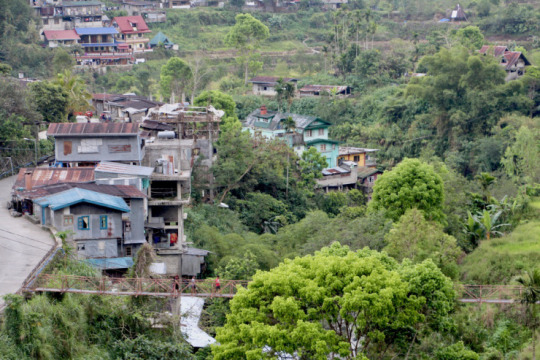
QUESTIONING
I love and I hate how you sometimes don’t care. The first example that comes to my mind is that huge ship in the port of Iloilo. It’s been laying there for months now and nobody seems to know what has happened to it. But even if it’s completely broken, everything would be more profitable than leaving it there. Oh well, the ship made me laugh every time but in truth it’s very sad. How are you supposed to grow/evolve when you’re not aware of your resources and capabilities?

GETTING MAD
This leads me to my favorite topic of anger: the rubbish situation. This is the one thing I cannot make you responsible for, yet cannot forgive you. I know you have bigger fish to fry. I just wish you would rudimentarily be aware of what an extraordinary beautiful ecosystem your islands are. Or at least for your own health, stop burning rubbish. I tried my best, but the war against plastic bags is a Sisyphean challenge. I pray that it won’t be too late.

PUZZELING OVER
Not to begin with the mischiefs in your politics. It would be a lie to say nothing’s in progress in your country. Economical growth is happening in your capital, but the provinces don’t profit. It’s no wonder when local politics have been under the power of one family for decades. I had to realize that one can be dumb without end, as long as there’s money one can always have a career in politics. The whole situation is screaming for change, but how is it to be done? All I know is Duterte cannot be it. I never understood your admiration/the ignorance of what’s happening.
Did somebody say corruption? This makes me think of an anecdote that once happened to me when I wanted to withdraw money. “‘My request could not be processed’, why is that?” I asked the bank’s security guard and he answered with out looking up: “Because of power and corruption…”. The only time I ever got in touch with this stuff was at the immigration office I think. One of my all time favorite places… not. Every time I went there, the prices for my visa extension were different. It sounds funny but it made me angry to pay ridiculous extra fees like “express lane” that change nothing. But again, there’s nothing I can do about it.


NOT UNDERSTANDING
Your superstitions make me laugh and angry at the same time. How can you seriously believe in spirits, trolls and fairies? How can you be in bondage like that? And where I never got behind: how does all of this fall in line with christianity?
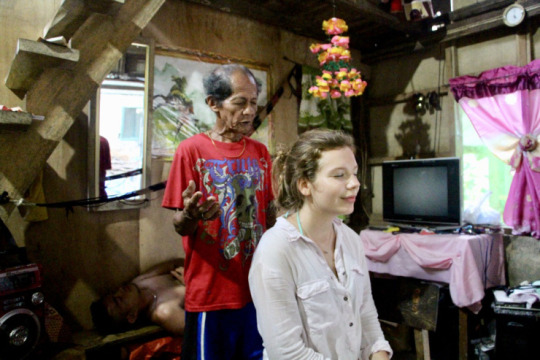
Visiting a healer on the supposedly enchanted island of Siquijor (full article)
EXPERIENCING
Speaking of your faith: you amazed me. Coming from the least religious place on earth, Eastern Germany, I couldn’t believe how so many – no actually all of you – believe. I have to say you live a strange version of Christianity. From horror stories of people who are voluntarily crucified during easter to celebrations of events that didn’t even happen according to the bible (some islands celebrate the reunion of Jesus and his mother after he was resurrected). Even though I’m convinced that a great part has never ever read a single page of the bible, it was a pleasure to see and feel your spirituality. I found it an interesting experience also regarding my own faith.
CELEBRATING
They call you an americanized piece of Spain, with no culture except what emperors of the past centuries have left with you. But good god, you know how to celebrate fiesta! And even if there’s Lechon (pigling) for every single occasion it doesn’t matter. These events are your own. Even if I can barely finish one plate of food by courtesy, I would always go, because this is you in a nutshell. Fiesta means family, food, hospitality, karaoke, more food and Lechon obviously. I was blown away by Dinagyang festival in January. As much as I hated the beauty contest, I loved the tribe performances.



On your thousands of islands the party never stops. As much as I regretted every night club visit in Iloilo, I wish back to all the fun nights in Smallville (night life district of Iloilo) or your cozy beach bars. I mean, what kind of world is it, where rum is cheaper than coke? It was a hell of a New Years Eve in Boracay last year – salamat gid Bryan.

One year wearing slippers and the shittiest clothes, like grandma-style maxi skirts. It didn’t matter at all, because I would still be “Miss beautiful” for you. And to speak the whole truth: All of them mold anyway.

Among the things I miss the most, your Jeepneys definitely make the top 3. Regardless if in the front, in the back, on the roof, with chicken between my feet or a 100 year old lollo (grandpa) on my lap – I love riding a jeepney! Jeepneys are a lifestyle. Even though they’re super loud and probably the main polluters, they will always have a special place in my heart. 🙂
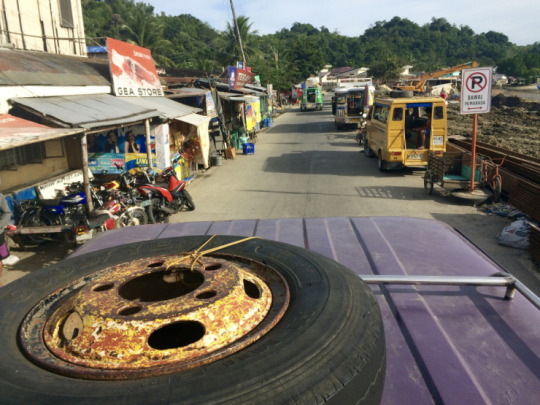


EATING
Unfortunately I cannot say the same about your food. To summarize this long story of suffering, I’ll just say: you stay under your possibilities. With out doubt the best you have to offer is your fruit. I love all of them and they outclass everything my german super markt offers.

As the good filipina I am, I love rice a lot even though I gained a lot of weight because of it…

I would like to take the opportunity to pick the grossest and yummiest you have to offer. Basically I’m a huge fan of your vegetarian dishes like fried eggplant, bitter melon or munggo. Furthermore I would never turn down a sweet sin like a fresh halo halo, banana cue or bibingka.
But as much as I’d like to, I have no understanding why and how you can enjoy a boiled developing duck embryo (balut), boiled pig blood, duck feet or pig intestines. I am more than sure that I ate my lifetime ration of dried and later fried fish. There’s only one question left unanswered: How can you call this buko (coconut) salad?


TRAVELING
Oh Philippines, you have so much to offer. I will never forget the amazing memories I made when traveling from island to island, discovering your hidden gems. It’s hard to realize though that most of my friends from Iloilo won’t ever be able to see all this.
From the 8th world wonder: the Rice Terraces of Batad

to the Chocolate Hills and tarsiers of Bohol
to swimming with whale sharks and chasing waterfalls in Cebu

to diving in Apo Island and Coron
to island hopping and beaching in Siquijor and Palawan

As off-hook as it sounds, but during the course of visiting all those amazing places, one becomes kind of choosy. One natural wonder trumps the other and in the end it’s the quit and raw places that fascinate the most. I’m in love with all your unpopular paradises left for me to explore, unlike other southeastasian countries.




Iloilo city, you little piece of dirt. Filipinos call you City of Love but I’m afraid you cannot compete with Paris – the “other” city of love -, to be completely honest with you. Quite the opposite, you are kind of the only place that turned out a lot less – or rather not at all – beautiful, looking back. You’re importance is founded on your inhabitants, food places and open air concerts or art galleries you hold. Other than that you actualize the shady sides of urbanization. Among those firstly your terrible pollution, the dirt and waste in general; poverty and slums; waifs, adults throughout the day and drunk at night – to name a few. I’m glad I didn’t live here permanently, but I certainly enjoyed the big city life experience during the weekends. How special is though, to have my buko (coconut) juice lady of trust in a city on the other side of the world?
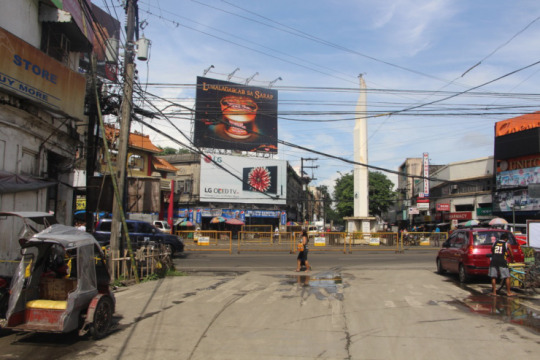

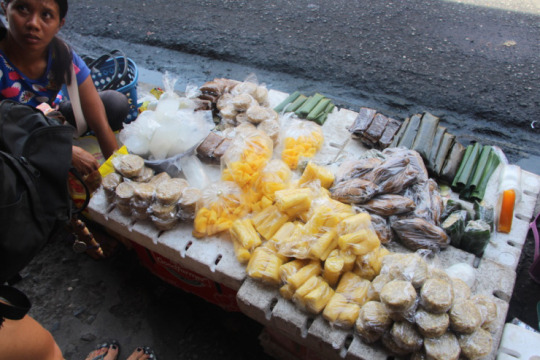

Guimaras my love, you are literally what I call paradise. I love you for much more than your mangoes, even though I love them a lot already. [Background information: Guimaras is the neighbouring island of Panay that is said to have the sweetest mangos in the world (full article). Once a year they hold a mango festival to worship them. Read about my mango-all-you-can-eat experience here.] You are a green wonderland, much needed escape, clean air, you are an untouched beauty. Stay the way you are please.



Thank you Philippines, for paving me the way to find eternal piece with me, myself and I and a hammock. The truth lies in the fact that one doesn’t need more than that. With this, a whole different style of traveling opened up to me. I reckon this is your most precious gift to me. I would NEVER have had the courage to hitchhike!


Yes it has a mosquito net! A local friend of mine invented them when traveling his country. They are manufactured by local women in Palawan. Get yours here

And like it is probably anywhere in the world: there are plenty of acquaintances and a precious hand full of friends. I am so thankful for every minute.
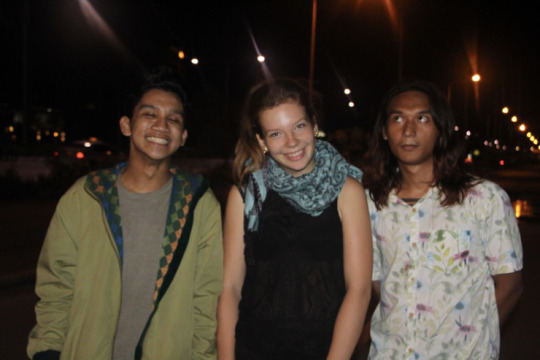
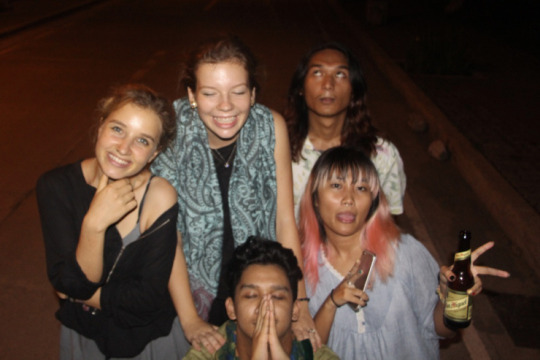
And of course salamat gid to my SOS family. There are obviously no words. You guys know already.

LEAVING
It felt weird and rash to leave you, when there was still war going on in Mindanao. When my little village got a bomb threat. When summer had finally ended and water started to run more frequently through my faucet. But really this was the end of my endless summer. It was a time of crisis, when ISIS raged in Marawi, relatives of the local islamists suddenly showed up at the port of Iloilo. When the NPA decided the time had come to take action again and raided the police station of our neighboring village Maasin. And all along I updated myself using foreign media. I didn’t want to feel unsafe on your streets at night, but how was I not to, when nobody had a clue what was going on? Even though I was expecting our foreign office to withdraw us german volunteers any minute for the last couple of weeks, my return flight came earlier than expected. It was hectic, it was emotional and sudden.

COMING BACK
What I take along with me to “real life” is sadly less than I planned on. That’s how it always goes. Never underestimate the power of habits. But what I keep with me every day is the filipino point of view. Every time I walk the streets, my university or the super market. I cannot help but wonder what a filipino would think right now.
Sex tourism to me, is one of the worst felonies of mankind. The whole problem gets to me on a very personal level, when I see that the perpetrators live right here. Make it stop!

Even if I could, I wouldn’t change a single thing about our year together. Mahal kita, and: nahidlaw ako gid sa imyo ❤


PS: Again I cannot help but recommend again everybody to watch this really close up documentary. And this little video by my fellow volunteer Gwen: It is so accurate, it bursted me to tears 🙂
Filipina for one year Dear Philippines, where should I start? It's been a rough and bumpy year for the two of us.
#asia#backpacking#gapyear#hammock#itsmorefuninthephilippines#neverstopexploring#philippines#travel#travelblogger#travelphotography#volunteer#wanderlust
0 notes